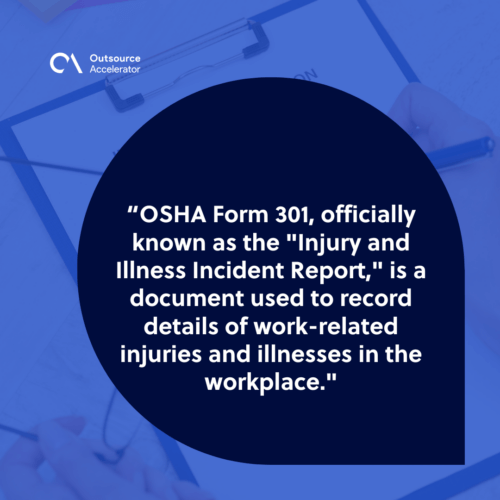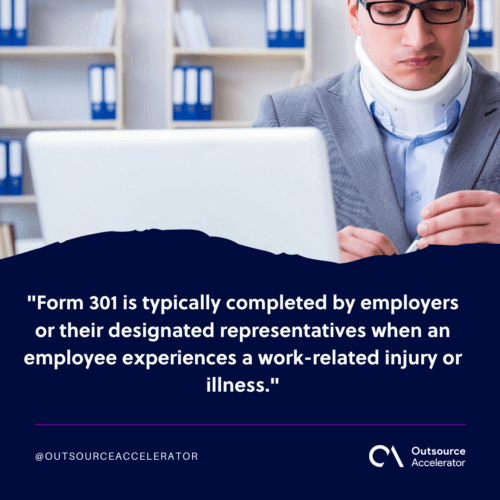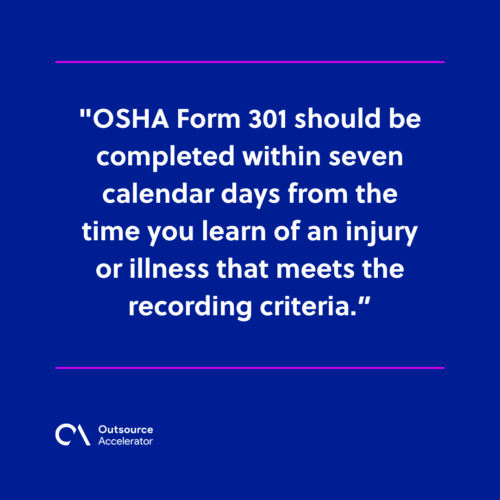Understanding OSHA Form 301

Safety in the workplace is a vital aspect of any business. To ensure the health and well-being of employees, it is important to comply with Occupational Safety and Health Administration (OSHA) regulations.
One such compliance requirement is the completion of OSHA Form 301.
In this article, we’ll take a closer look at what OSHA Form 301 entails. We’ll discuss who needs to file it, the information recorded, when to complete it, and the consequences of not filing it.
What is OSHA Form 301?
See OSHA Form 301 (Rev. 04/2004)
OSHA Form 301, officially known as the “Injury and Illness Incident Report,” is a document used to record details of work-related injuries and illnesses in the workplace.

The form is located within OSHA Form 300, which records and categorizes workplace incidents. Incidents recorded on Form 301 are:
- Deaths
- Injuries or illnesses leading to unconsciousness, days off, restricted work, or job transfers
- Irreversible chronic conditions, diagnosed cancer, broken teeth or bones, and punctured eardrums
- Injuries needing professional care
Injuries that only need first aid, such as bandages or ice packs, don’t need to be documented. Specific conditions like tuberculosis and hearing loss have different recording rules.
Unlike other OSHA forms that focus on summarizing incidents, Form 301 delves into the specifics. It provides a comprehensive narrative that aids in understanding the nature and circumstances surrounding each case.
The form is essential to employers’ injury and illness record-keeping requirements. It provides valuable data to identify workplace hazards, improve safety measures, and ultimately prevent accidents.
Who must file Form 301?
Form 301 is typically completed by employers or their designated representatives when an employee experiences a work-related injury or illness.
It is an integral part of OSHA’s larger recordkeeping system, which includes Forms 300 and 300A.
Employers with more than ten employees engaged in industries covered by OSHA regulations are generally required to maintain these records.
However, certain industries and specific criteria may exempt some employers from this requirement. Reviewing OSHA guidelines or consulting with a legal professional to determine whether your business falls under this mandate is crucial.

Information recorded in OSHA Form 301
The strength of OSHA Form 301 lies in its ability to capture detailed information. When completing this form, employers are expected to provide:
- Employee information. This includes the affected employee’s name, job title, and department.
- Injury or illness details. A comprehensive description of the nature of the injury or illness, including affected body parts and the date and time of occurrence.
- Event or exposure. The circumstances leading to the incident, detailing the events or exposures that resulted in the injury or illness.
- Medical treatment. The type of medical treatment administered, whether it involved first aid, a clinic visit, or hospitalization.
- Healthcare details. This includes the name of the healthcare professional who provided the treatment and where the injury was treated.
- Days away from work. The number of days should be recorded if the employee had to take days off due to an injury or illness.
- Return to work status. The form captures information about whether the employee has returned to work and if there are any restrictions on their duties.
- Details in case of death. If an employee dies, the date and time should be recorded along with the direct cause.
To ensure accurate and complete records, OSHA Form 301 should be filled out promptly after the incident.
Employers must gather information from the employees, witnesses, and health professionals involved in treating the injured or ill worker.
When to complete Form 301
OSHA Form 301 should be completed within seven calendar days from the time you learn of an injury or illness that meets the recording criteria.
This timeline allows employers to document incidents promptly while the details are still fresh, ensuring accuracy in the report.
It is important to note that completing Form 301 is only one component of OSHA’s record-keeping requirements.
Employers must also track and maintain records of work-related injuries and illnesses using OSHA Forms 300 (Log of Work-Related Injuries and Illnesses) and 300A (Summary of Work-Related Injuries and Illnesses).
These forms provide a comprehensive picture of the workplace safety landscape.

What if you don’t file Form 301?
Failure to comply with OSHA recordkeeping requirements, including completing Form 301, can lead to serious consequences.
Beyond the ethical obligation to prioritize employee well-being, non-compliance can result in penalties and legal issues for the employer.
OSHA has the authority to issue citations and fines for recordkeeping violations, and these penalties can escalate if the violations are deemed willful or repetitive.
Employers can keep Form 301 on file for at least five years after the year the incident occurred.
In addition to the legal repercussions, the absence of accurate recordkeeping can hinder the identification of workplace hazards and the implementation of preventive measures.
It’s not just about meeting regulatory requirements — it’s about fostering a safe and healthy work environment for your team.







 Independent
Independent




